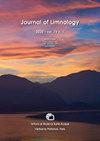Limnology for the ornithologist: effects of Lake Maggiore water level on migratory flows
IF 1.1
4区 环境科学与生态学
Q4 LIMNOLOGY
引用次数: 1
Abstract
Wetlands are widely recognised as the most critical stop-over locations along migration flyways. Wetland ecology is mostly influenced by water levels and water regimes. This research focuses on Bolle di Magadino (Switzerland), an important stop-over site on Lake Maggiore, artificially regulated by a dam. In this work we examined how the artificial flooding of a wetland affects the use of this stop-over site by migrating passerines during spring. Bird presence in the area was evaluated using both data collected at the ringing station located in the wetlands and the bird traffic rate (BTR) supplied by the BirdScan MR1, an avian verticallooking radar (VLR) capable of automatically detecting and classifying birds in flight. In an attempt to shed light on the effect of lake level on stop-over quality, we i) simulated with GIS the extent of the flooded area and of the different habitat categories as the lake level changes; ii) calculated the relationship between lake level and the ability of stop-overing birds to acquire trophic resources; iii) verified that the flux of passerines below 500 m above ground level measured by radar could be used as a proxy for the number of stop-overing birds; iv) calculated the relationship between the number of birds leaving the stop-over and the lake level. While the number of ringed passerines has proven to be representative of the migratory flow below 500 meters of altitude at the site of interest, a high lake level seems to have a negative impact on the use by some species of the Bolle di Magadino area as a stop-over site during spring. In particular, two of the target species -the blackcap and the reed bunting- have proven to be sensitive to higher water levels. While taking into account the limitations and the relative nature of the results, could be necessary for the competent authorities to take these results into consideration in order to safeguard the Bolle di Magadino’s role as an important stop-over area during spring.鸟类学家的湖沼学:马焦雷湖水位对迁徙流量的影响
湿地被广泛认为是迁徙途中最重要的中途停留地。湿地生态主要受水位和水势的影响。本研究的重点是瑞士的Bolle di Magadino,这是马焦雷湖上一个重要的中转站,由大坝人工调节。在这项工作中,我们研究了湿地的人工洪水如何影响春季迁徙雀鸟对这个中途停留地点的使用。研究人员利用位于湿地的环形站收集的数据和BirdScan MR1提供的鸟类交通率(BTR)来评估该地区的鸟类存在情况。BirdScan MR1是一种鸟类垂直雷达(VLR),能够自动探测和分类飞行中的鸟类。为了揭示湖泊水位对过境质量的影响,利用GIS模拟了随着湖泊水位的变化,被淹没区域的范围和不同生境类别的变化;Ii)计算了湖泊水位与停飞鸟类获取营养资源能力的关系;Iii)验证雷达测量的距离地面500 m以下雀形目鸟类的通量可作为停飞鸟类数量的代表;(4)计算出离站鸟类数量与湖面的关系。虽然环状雀形鸟的数量已被证明是500米以下的迁徙流量的代表,但高水位似乎对Bolle di Magadino地区的一些物种在春季作为中转站产生了负面影响。特别是,两种目标物种——黑帽和芦苇狩猎——已被证明对更高的水位很敏感。在考虑到结果的局限性和相对性质的同时,主管当局可能有必要考虑这些结果,以保障马加迪诺堡作为春季重要中途停留地区的作用。
本文章由计算机程序翻译,如有差异,请以英文原文为准。
求助全文
约1分钟内获得全文
求助全文
来源期刊

Journal of Limnology
地学-湖沼学
CiteScore
2.70
自引率
6.20%
发文量
12
审稿时长
3 months
期刊介绍:
The Journal of Limnology publishes peer-reviewed original papers, review papers and notes about all aspects of limnology. The scope of the Journal of Limnology comprises the ecology, biology, microbiology, physics, and chemistry of freshwaters, including the impact of human activities, management and conservation. Coverage includes molecular-, organism-, community-, and ecosystem-level studies on both applied and theoretical issues. Proceedings of workshops, specialized symposia, conferences, may also be accepted for publication.
 求助内容:
求助内容: 应助结果提醒方式:
应助结果提醒方式:


